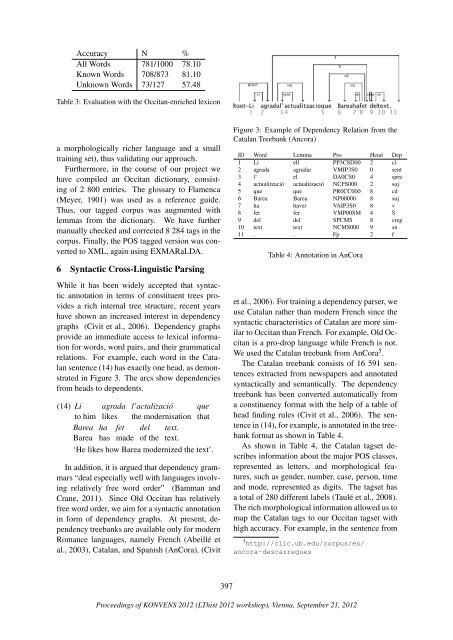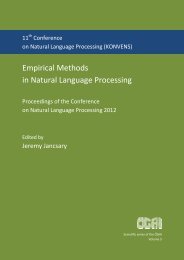Building an old Occitan corpus via cross-Language transfer
Building an old Occitan corpus via cross-Language transfer
Building an old Occitan corpus via cross-Language transfer
You also want an ePaper? Increase the reach of your titles
YUMPU automatically turns print PDFs into web optimized ePapers that Google loves.
Accuracy N %<br />
All Words 781/1000 78.10<br />
Known Words 708/873 81.10<br />
Unknown Words 73/127 57.48<br />
Table 3: Evaluation with the Occit<strong>an</strong>-enriched lexicon<br />
a morphologically richer l<strong>an</strong>guage <strong>an</strong>d a small<br />
training set), thus validating our approach.<br />
Furthermore, in the course of our project we<br />
have compiled <strong>an</strong> Occit<strong>an</strong> dictionary, consisting<br />
of 2 800 entries. The glossary to Flamenca<br />
(Meyer, 1901) was used as a reference guide.<br />
Thus, our tagged <strong>corpus</strong> was augmented with<br />
lemmas from the dictionary. We have further<br />
m<strong>an</strong>ually checked <strong>an</strong>d corrected 8 284 tags in the<br />
<strong>corpus</strong>. Finally, the POS tagged version was converted<br />
to XML, again using EXMARaLDA.<br />
6 Syntactic Cross-Linguistic Parsing<br />
While it has been widely accepted that syntactic<br />
<strong>an</strong>notation in terms of constituent trees provides<br />
a rich internal tree structure, recent years<br />
have shown <strong>an</strong> increased interest in dependency<br />
graphs (Civit et al., 2006). Dependency graphs<br />
provide <strong>an</strong> immediate access to lexical information<br />
for words, word pairs, <strong>an</strong>d their grammatical<br />
relations. For example, each word in the Catal<strong>an</strong><br />
sentence (14) has exactly one head, as demonstrated<br />
in Figure 3. The arcs show dependencies<br />
from heads to dependents.<br />
(14) Li<br />
to him<br />
Barea<br />
Barea<br />
agrada<br />
likes<br />
ha<br />
has<br />
fet<br />
made<br />
l’actalizació<br />
the modernisation<br />
del text.<br />
of the text.<br />
que<br />
that<br />
‘He likes how Barea modernized the text’.<br />
In addition, it is argued that dependency grammars<br />
“deal especially well with l<strong>an</strong>guages involving<br />
relatively free word order” (Bamm<strong>an</strong> <strong>an</strong>d<br />
Cr<strong>an</strong>e, 2011). Since Old Occit<strong>an</strong> has relatively<br />
free word order, we aim for a syntactic <strong>an</strong>notation<br />
in form of dependency graphs. At present, dependency<br />
treeb<strong>an</strong>ks are available only for modern<br />
Rom<strong>an</strong>ce l<strong>an</strong>guages, namely French (Abeillé et<br />
al., 2003), Catal<strong>an</strong>, <strong>an</strong>d Sp<strong>an</strong>ish (AnCora), (Civit<br />
Figure 3: Example of Dependency Relation from the<br />
Catal<strong>an</strong> Treeb<strong>an</strong>k (Ancora)<br />
ID Word Lemma Pos Head Dep<br />
1 Li ell PP3CSD00 2 ci<br />
2 agrada agradar VMIP3S0 0 sent<br />
3 l’ el DA0CS0 4 spec<br />
4 actualització actualització NCFS000 2 suj<br />
5 que que PR0CC000 8 cd<br />
6 Barea Barea NP00000 8 suj<br />
7 ha haver VAIP3S0 8 v<br />
8 fet fer VMP00SM 4 S<br />
9 del del SPCMS 8 creg<br />
10 text text NCMS000 9 sn<br />
11 . . Fp 2 f<br />
Table 4: Annotation in AnCora<br />
et al., 2006). For training a dependency parser, we<br />
use Catal<strong>an</strong> rather th<strong>an</strong> modern French since the<br />
syntactic characteristics of Catal<strong>an</strong> are more similar<br />
to Occit<strong>an</strong> th<strong>an</strong> French. For example, Old Occit<strong>an</strong><br />
is a pro-drop l<strong>an</strong>guage while French is not.<br />
We used the Catal<strong>an</strong> treeb<strong>an</strong>k from AnCora 5 .<br />
The Catal<strong>an</strong> treeb<strong>an</strong>k consists of 16 591 sentences<br />
extracted from newspapers <strong>an</strong>d <strong>an</strong>notated<br />
syntactically <strong>an</strong>d sem<strong>an</strong>tically. The dependency<br />
treeb<strong>an</strong>k has been converted automatically from<br />
a constituency format with the help of a table of<br />
head finding rules (Civit et al., 2006). The sentence<br />
in (14), for example, is <strong>an</strong>notated in the treeb<strong>an</strong>k<br />
format as shown in Table 4.<br />
As shown in Table 4, the Catal<strong>an</strong> tagset describes<br />
information about the major POS classes,<br />
represented as letters, <strong>an</strong>d morphological features,<br />
such as gender, number, case, person, time<br />
<strong>an</strong>d mode, represented as digits. The tagset has<br />
a total of 280 different labels (Taulé et al., 2008).<br />
The rich morphological information allowed us to<br />
map the Catal<strong>an</strong> tags to our Occit<strong>an</strong> tagset with<br />
high accuracy. For example, in the sentence from<br />
5 http://clic.ub.edu/<strong>corpus</strong>/en/<br />
<strong>an</strong>cora-descarregues<br />
397<br />
Proceedings of KONVENS 2012 (LThist 2012 workshop), Vienna, September 21, 2012





